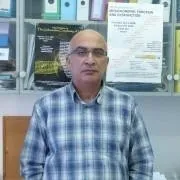 For many years, our laboratory has been interested primarily in unravelling the molecular mechanism behind the function of two groups of proteins. One is the sophisticated machinery that mitochondria use for translocating proteins from the cytosol. Most mitochondrial proteins are encoded in the nuclear genome, synthesized in the cytosol as preproteins and then imported into mitochondria. Uptake of these preproteins into the mitochondria is mediated by a number of oligomeric protein complexes, which are found in the cytosol, outer mitochondrial membrane, intermembrane space, inner mitochondrial membrane and in the mitochondrial matrix. The translocase of the inner membrane, TIM23 complex, with its associated proteins, is the focus of one major project in our laboratory.
For many years, our laboratory has been interested primarily in unravelling the molecular mechanism behind the function of two groups of proteins. One is the sophisticated machinery that mitochondria use for translocating proteins from the cytosol. Most mitochondrial proteins are encoded in the nuclear genome, synthesized in the cytosol as preproteins and then imported into mitochondria. Uptake of these preproteins into the mitochondria is mediated by a number of oligomeric protein complexes, which are found in the cytosol, outer mitochondrial membrane, intermembrane space, inner mitochondrial membrane and in the mitochondrial matrix. The translocase of the inner membrane, TIM23 complex, with its associated proteins, is the focus of one major project in our laboratory.
The second major topic of our research is the chaperonin family of proteins. The most well-known are the GroEL and GroES proteins of E. coli. The cpn60 (or Hsp60) protein (GroEL) binds to nascent or stress-denatured proteins and facilitates their refolding with the assistance of the cpn10 (Hsp10, GroES) co-chaperonin. In mitochondria, Hsp60 mediates the folding of proteins that have been translocated from the cytosol to the matrix. The importance of these chaperonins in mitochondria is highlighted by the discovery of genetic diseases caused by mutations in these proteins, and of extramitochondrial roles, some related to cancer development. We have been studying the structure and function of mitochondrial and chloroplast chaperonins in vitro. Recently, we published the first crystal structure of the the mitochondrial chaperonin complex, which lent insight into the unique mechanism of this system.
More recently, we have become interested in the mechanism behind genetic diseases. Modern deep-sequencing technologies have facilitated the identification of mutations responsible for recessive genetic diseases. We use this information to delineate the molecular basis of the disease, taking a two-pronged approach. We utilize a yeast model to study the effects of the mutated protein in a biological system. In parallel, we produce the mutated protein and purify it in vitro, in order to investigate its properties and its interaction with other proteins.
.
Selected Puplications
Nisemblat, S., Yaniv, O., Parnas, A., Frolow, F. & Azem, A. (2015) Crystal structure of the human mitochondrial chaperonin symmetrical football complex, Proc Natl Acad Sci U S A. 112, 6044-9.
Demishtein-Zohary, K., Marom, M., Neupert, W., Mokranjac, D. & Azem, A. (2015) GxxxG motifs hold the TIM23 complex together, FEBS J. 282, 2178-86.
Waegemann, K., Popov-Celeketic, D., Neupert, W., Azem, A. & Mokranjac, D. (2015) Cooperation of TOM and TIM23 complexes during translocation of proteins into mitochondria, J Mol Biol. 427, 1075-84.
Vitlin Gruber, A., Zizelski, G., Azem, A. & Weiss, C. (2014) The Cpn10(1) co-chaperonin of A. thaliana functions only as a hetero-oligomer with Cpn20, PLoS One. 9, e113835.
Sharabi, M., Mandelberg, Y., Benayahu, D., Benayahu, Y., Azem, A. & Haj-Ali, R. (2014) A new class of bio-composite materials of unique collagen fibers, J Mech Behav Biomed Mater. 36, 71-81.
Nisemblat, S., Parnas, A., Yaniv, O., Azem, A. & Frolow, F. (2014) Crystallization and structure determination of a symmetrical ‘football’ complex of the mammalian mitochondrial Hsp60-Hsp10 chaperonins, Acta Crystallogr F Struct Biol Commun. 70, 116-9.
Vitlin Gruber, A., Nisemblat, S., Azem, A. & Weiss, C. (2013) The complexity of chloroplast chaperonins, Trends Plant Sci. 18, 688-94.
Marom, M. & Azem, A. (2013) The use of cardiolipin-containing liposomes as a model system to study the interaction between proteins and the inner mitochondrial membrane, Methods Mol Biol. 1033, 147-55.
Azoulay, I., Kucherenko, N., Nachliel, E., Gutman, M., Azem, A. & Tsfadia, Y. (2013) Tracking the interplay between bound peptide and the lid domain of DnaK, using molecular dynamics, Int J Mol Sci. 14, 12675-95.
Sharkia, R., Mahajnah, M., Zalan, A., Athamna, M., Azem, A., Badarneh, K. & Faris, F. (2013) Comparative screening of FMF mutations in various communities of the Israeli society, Eur J Med Genet. 56, 351-5.
Priya, S., Sharma, S. K., Sood, V., Mattoo, R. U., Finka, A., Azem, A., De Los Rios, P. & Goloubinoff, P. (2013) GroEL and CCT are catalytic unfoldases mediating out-of-cage polypeptide refolding without ATP, Proc Natl Acad Sci U S A. 110, 7199-204.
Vitlin Gruber, A., Nisemblat, S., Zizelski, G., Parnas, A., Dzikowski, R., Azem, A. & Weiss, C. (2013) P. falciparum cpn20 is a bona fide co-chaperonin that can replace GroES in E. coli, PLoS One. 8, e53909.
Schusdziarra, C., Blamowska, M., Azem, A. & Hell, K. (2013) Methylation-controlled J-protein MCJ acts in the import of proteins into human mitochondria, Hum Mol Genet. 22, 1348-57.
Kuo, W. Y., Huang, C. H., Liu, A. C., Cheng, C. P., Li, S. H., Chang, W. C., Weiss, C., Azem, A. & Jinn, T. L. (2013) CHAPERONIN 20 mediates iron superoxide dismutase (FeSOD) activity independent of its co-chaperonin role in Arabidopsis chloroplasts, New Phytol. 197, 99-110.
Parnas, A., Nisemblat, S., Weiss, C., Levy-Rimler, G., Pri-Or, A., Zor, T., Lund, P. A., Bross, P. & Azem, A. (2012) Identification of elements that dictate the specificity of mitochondrial Hsp60 for its co-chaperonin, PLoS One. 7, e50318.
Iosefson, O., Sharon, S., Goloubinoff, P. & Azem, A. (2012) Reactivation of protein aggregates by mortalin and Tid1–the human mitochondrial Hsp70 chaperone system, Cell Stress Chaperones. 17, 57-66.
Marom, M., Dayan, D., Demishtein-Zohary, K., Mokranjac, D., Neupert, W. & Azem, A. (2011) Direct interaction of mitochondrial targeting presequences with purified components of the TIM23 protein complex, J Biol Chem. 286, 43809-15.
Vitlin, A., Weiss, C., Demishtein-Zohary, K., Rasouly, A., Levin, D., Pisanty-Farchi, O., Breiman, A. & Azem, A. (2011) Chloroplast beta chaperonins from A. thaliana function with endogenous cpn10 homologs in vitro, Plant Mol Biol. 77, 105-15.
Marom, M., Azem, A. & Mokranjac, D. (2011) Understanding the molecular mechanism of protein translocation across the mitochondrial inner membrane: still a long way to go, Biochim Biophys Acta. 1808, 990-1001.

